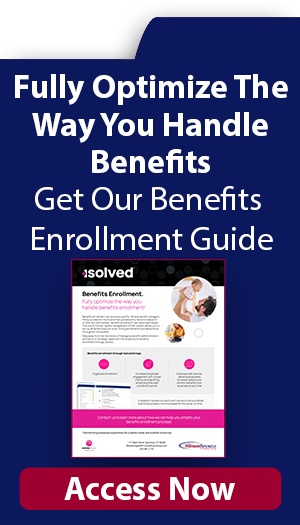Employee benefits are an essential part of any compensation package. They can help attract candidates, improve employee morale, boost employee performance, and retain top talent.
How to Optimize Employee Benefits to Create Better Business Outcomes
There is a multitude of employee benefits, from the common, such as health, dental, and vision insurance, paid time off, and 401(k) or other retirement savings plans, to the less common, such as supplemental or voluntary life insurance, disability insurance, tuition reimbursement, childcare reimbursement, pet insurance, and much more. The most effective employee benefits packages will vary depending on the needs of an organization and its employees.
Employee Benefits Strategy: Latest Trends
One of the first critical steps in optimizing an organization’s employee benefits offerings is staying up-to-date on the latest trends. This can help identify gaps in the current program and ensure that the most competitive benefits package possible is being offered. Some of the latest trends in employee benefits include:
- Healthcare Plan Variations and Alternatives - With healthcare costs continuing to rise, employers are looking for ways to control costs while still providing quality coverage for their employees. High-deductible health plans, health savings accounts, and telehealth services are all becoming more popular as employers look for ways to control costs.
- Retirement Plan Variations and Alternatives - With traditional pensions becoming less common, employers are turning to 401(k) plans and other retirement savings options to provide retirement income for their employees. Employers are also starting to offer financial wellness programs to help employees save for retirement and other financial goals.
- Work/Life Balance - With more employees working remotely or having flexible schedules, employers are offering more programs and perks focused on work/life balance as well as other more creative benefits for employees. These can include things like paid time off for volunteering, flexible work hours, and telecommuting options. However, it's important that employers find ways to implement these strategies efficiently, such as optimizing hybrid work models.
Employee Benefits Strategy: What to Consider
During the consideration phase, it’s crucial to fully recognize how to manage and administer the benefits to drive optimized business outcomes, be it employee acquisition, retention, or cost savings.
- The employee benefits strategy should align with the acquisition and retention strategies. In the midst of a significant hiring push or hiring freeze? Have a large workforce or a small team? Consider which benefits may be redundant or less cost-effective for current and future employees.
- Consider the appropriate level of coverage at the right price point. What are the demographics of your workforce? It may not make the most sense to have only high-cost ‘Cadillac’ plans as options for the team, especially if the cost-sharing puts a greater financial burden on the employee.
- Understand the Federal and State laws. In Connecticut, the Paid Family and Medical Leave Act offers Connecticut workers the opportunity to take time to attend to personal and family health needs without worrying about lost income. Understanding how this may affect PTO policies and supplemental insurance benefits is essential.
- Understand the cost-to-value relationships between certain benefits. Some benefits, such as life and disability insurance are relatively low-cost for the employer but can have high value for employees from the perspective of retention.
- Review the contribution methodology. With defined benefits vs. defined contribution, it’s important to balance the considerations of limited options and cost, versus more clearly managing cash flow and offering flexibility. Take an approach that effectively matches the needs of the majority of current and future employees.
- When an employee has a question, ensure that they have someone to speak with regarding your benefit offerings. In many cases, the broker isn’t quite as accessible or available as a company may like. This is where a company like The Human Resource Consulting Group steps in, consistently ensuring that employees have someone to speak directly with. Plans get loaded into an easily accessible portal, along with all the employee information and contribution methodology. This reduces the need to frequently answer basic questions and gives employees and employers real-time access to key information.
Tips to Optimize Employee Benefits
- Take time to understand employees’ needs. The first step in any effective benefits management strategy is to understand the needs of the employees, particularly within the context of the existing business and future plans. What are their biggest concerns? What do they value most in a benefits package? Take the time to survey and understand the employees, in order to tailor the benefits offerings to meet their specific needs.
- Review the benefits package regularly. Employees’ needs will change over time, so it’s important to review the benefits package regularly. Make sure that the right mix of benefits is being offered, and that the business is keeping up with changes in the marketplace. For example, if health insurance is being offered, is it comprehensive and affordable? If a retirement savings plan is offered, is it competitive with other plans offered by similar businesses?
- Communicate with the employees about their benefits. Employees can’t take advantage of their benefits if they don’t know what they are or how to access them. Make sure there is clear and concise communication about all of the different benefits that are available to the employees. It is also important to provide information about how they can enroll in the different programs and how to contact someone if they have questions.
- Work with a trusted partner. Employee benefits can be complex, so it’s important to work with a trusted partner who can help navigate the landscape. A good partner will have a deep understanding of the different options available and will be able to help find the right mix of benefits for the business. They will also be there to help administer the program and resolve any issues that may arise.
HR Benefits Strategy Consulting
Employee benefits play an essential role in any business. Keeping up with the latest trends and ensuring the benefits program is optimized for maximum business outcomes takes time and effort. Staying up-to-date on industry trends, designing a comprehensive yet affordable employee benefits plan tailored specifically for the organization's needs, and using technology where possible to automate processes, make administering these said programs much more manageable.
Think outside of the box and work with your employees to find unique benefits, such as the Connecticut 'Hero Pay' fund. And finally, working with an experienced advisor eases any burden placed on business owners or internal HR staff while freeing them up to focus energy elsewhere within the organization where time might be better spent!





